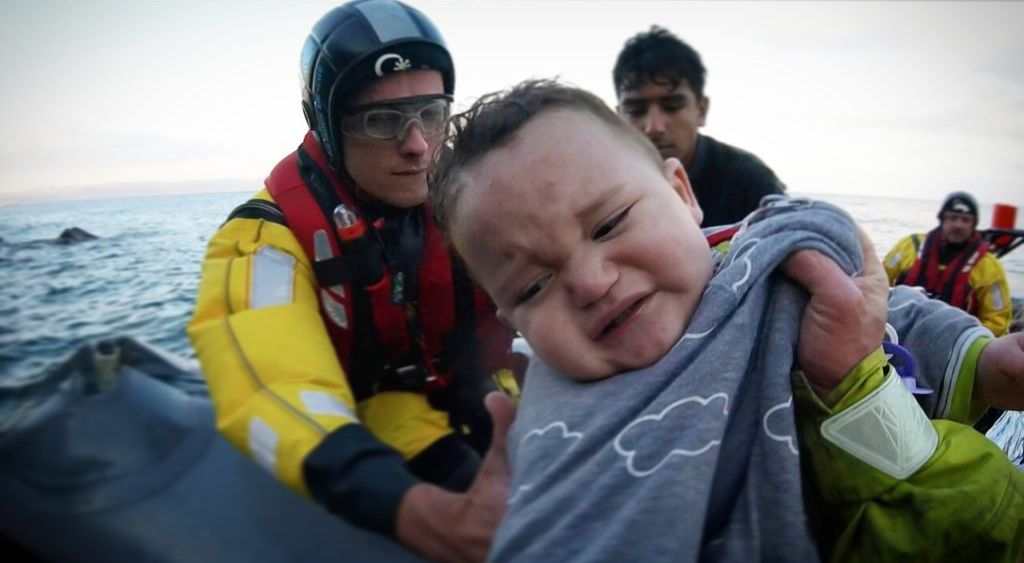
It was September of 2015 when Irish curator Jude Bennett watched a police officer scoop up the tiny body of three-year-old Aylan Kurdi from the beach near the Turkish resort of Bodrum. The Syrian toddler had drowned, along with his five year-old brother Galip, when their father loaded them onto a crowded dinghy in a desperate effort to escape the war in Syria.
Bennett, who was then working at the Cardiff artists space g39, watched the televised footage inside her apartment in Bristol. Seeing the images, she felt like her heart would jump out of her chest. As she tells it, she knew a Belfast musician named Joby Fox who had recently traveled to Lesbos to volunteer in rescue operations. “He was pleading on Facebook for help to get back out there,” she remembers. Unable to get the infant’s face out of her head, she rang him and asked a simple question: “Can I help?”
These were the inauspicious beginnings of Refugee Rescue, an artist-heavy volunteer search and rescue team based on the Greek island of Lesbos. Registered as a European charity by both Bennett and Fox in late 2015, the organization serves a lifesaving mission for the 200 to 300 refugees a week—they hail mostly from Syria, Afghanistan, Iraq, Somalia and Sudan— that attempt the treacherous 3.5 mile sea crossing between Turkey and the island. Despite the fact that Refugee Rescue started out as a scrappy beach-bound group, they were soon buoyed by an unexpected gift: a 32,000-euro, Atlantic 75-class lifeboat donated by Jake Chapman, half of the famous British artist duo Jake and Dinos Chapman.
Jude Bennett, Co-Founder Refugee Rescue. Courtesy: Refugee Rescue.
Bestowed anonymously, Chapman’s gift literally made the group’s mission seaworthy. As Fox told a Belfast news outlet last January: “We’ve been using a human chain to reach the people who fall in the water, but it’s treacherous for everyone. It’s freezing, frightening and very dangerous. So having this boat will make all the difference.”
“When we first got to Lesbos,” Bennett told me from the relative calm of a Copenhagen respite, “there was only one jet-ski and no rescue boats. A tech in Jake’s studio knew about Refugee Rescue, so he phoned me up. I told Jake what things were like on the ground and suggested he come down. Towards the end of the conversation, he said he wanted to pitch in personally. Not long after, I was inspecting the boat in Bristol, and driving back to Greece to get the crew together and do the paperwork.”
Speaking by phone from his studio in London, Chapman was keen to articulate the rationale behind about what has, until recently, been an anonymous contribution. “First, I think state actors really have the primary responsibility to fix this mess as opposed to individuals,” he says. “Also, I’m very cautious about the idea that charity pays off guilt. But seeing the practical nature of what Refugee Rescue were doing, I decided it was actually harder to avoid helping than to pitch in and help. I’m not being euphemistic when I say that buying the boat and sending it to Greece was the least I could do.”
Jake Chapman.
Photo credit: Nic Serpell-Rand Photography.
Not wanting his gift to be mistaken for art, Chapman describes Refugee Rescue’s mission as pragmatic in the extreme: “The magnitude of what’s going on in Lesbos is awful. It’s about dragging people the last hundred meters to shore. Buying the boat and fundraising, therefore, is not symbolic, it’s a set of transactional facts, and totally practical. There’s something pathetic about Ai Weiwei going to lie down on the beach to aestheticize others people’s misery. That’s not what’s happening here at all.”
Part of what Chapman and Rescue Refugee aim to do by outing the British artist is to bring additional attention to an organization that currently survives, in Bennett’s words, “very much hand to mouth.” The goal, she says, is to transform the group from one with monthly objectives into one that can plan at least two years in advance. Both Bennett and Chapman say that an art auction to benefit Refugee Rescue is planned for mid-March.
“For a while there were a number of rescue boats in Lesbos,” Bennett says about the politically-influenced ebb and flow of NGOs in the area, “but now we’re back to being the only one. We’re on call twenty-four seven, though most of the crossings happen at night. This puts a lot of stress on the crew but also on the boat, which needs to be maintained. It costs about 60 euros an hour to run the boat, about 15,000 euros a month for the boat and crew, and about 180,000 euros a year for entire operation. We’re a small and resourceful charity, but planning remains month to month right for now.”
Family rescued by Refugee Rescue. Courtesy: Refugee Rescue.
Despite the fact that nearly every volunteer involved in Refugee Rescue is an artist, the organization’s founder is also cautious to not draw too close a comparison to the art-led projects of other artists who have visited the area, or to the socially engaged artworks that will surely accompany Greece’s portion of the Documenta 14 art festival in June.
“The idea that you can do-it-yourself on the front lines of a crisis, that basic mentality of creative people, is really what made Refugee Rescue happen. But just because artists are our natural base of support, doesn’t mean that we’re using any of this as material for an art project, as some artists have done. What we’re doing is not art. It’s about how we can relate to others and help.”
When asked directly whether the rescue boat he funded could be considered art, Chapman was metaphorically succinct: “If it was art, it’d sink.”